Krishna and Tulsi (Tulasi) vivah (marriage) (full) story (As per Hindu Texts)
Namaste friends, how are you doing today? Welcome to #BhagavanBhakthi website / blog.
Bhagavan Lord Sri Krishna and Goddess Sri Tulasi (Tulsi) Devi blessings to you and your family!
In this website / blog, you will always learn about #Hinduism #Sanskrit language.
Also subscribe to my YouTube channel from this link #BhagavanBhakthi to view videos about #Hinduism #Sanskrit language.
Just before moving towards to know about “Krishna and Tulsi (Tulasi) vivah (marriage) (full) story (As per Hindu Texts)“, let us know few basic and important information.

Common questions asked regarding to this subject is as given below:
Was Krishna married to Tulsi? | How did Tulsi married to Krishna? | What is the story behind Tulsi and Krishna? |
When did Krishna marry Tulsi? | Krishna and Tulsi relation | Why did Tulsi cursed krishna and radha | Tulasi Devi story |
Why Tulsi is offered to Krishna | Story of Krishna and Tulsi | Who is Tulsi Devi husband | Devi Tulsi and Krishna story | Krishna Tulasi serial story | Any many more…
Let’s know answers to these questions and lot more in this post.
My dear friends, in this post (article), you will find maximum information about the Goddess Sri Tulasi Devi and her vivah (marriage) with Lord Sri Krishna.
And thus, I (author of this post / article) urge you all readers to read this post fully to get the utmost details about Goddess Sri Tulasi Devi and her vivah (marriage) with Lord Sri Krishna.
Introduction: During Samudra Manthan (churning of Ocean) (Amrit Manthan), Lord Sri Vishnu (Hari / Narayana) came in as Lord Sri Dhanvantari.
This avatar is called as Lord Sri Vishnu’s Vaidya Roopa (a physician), who came holding one Suvarna Kalash (Kalasha) (divine golden pot) comprising of Amrit from the samudra / ocean.
At that time, aananda ashru (divine happy eye drops – आनंद अश्रु) came out of Lord Sri Dhanvantari and these happy eye drops turned out to be Goddess Sri Tulasi Devi (Tulsi Devi).
It was on Kartika Purnima that the birth of Great Goddess Sri Tulasi Devi took place, that is, during the early morning Sri Tulasi Devi took her birth.
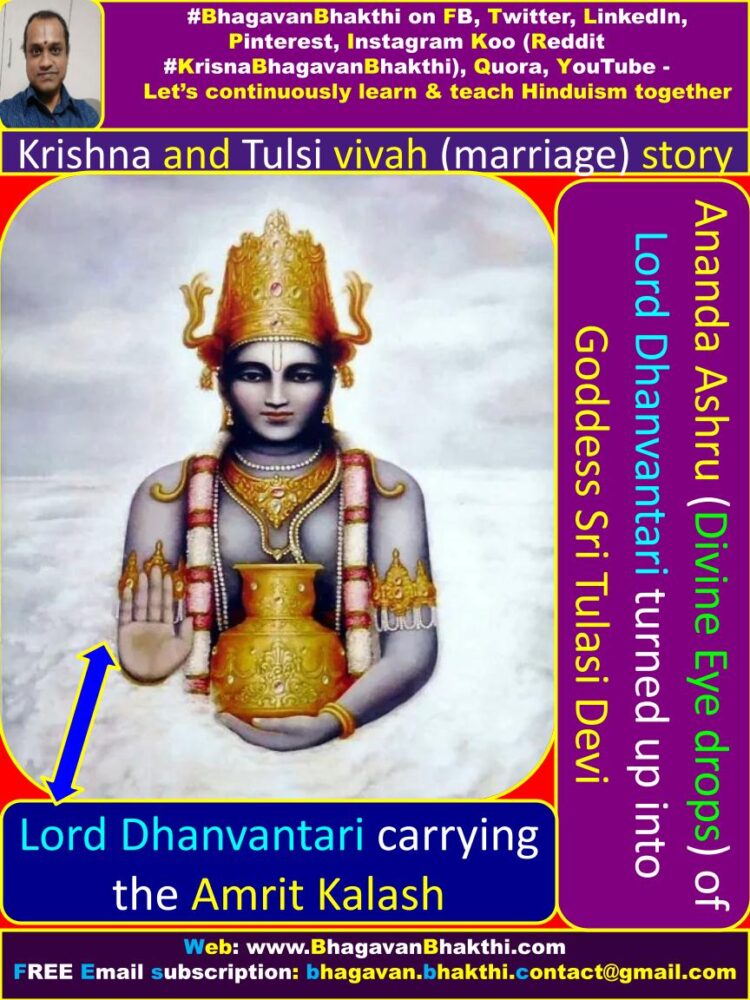
List of Krishna and Tulasi (Tulsi) vivah (marriage) facts are as given below:
Tulsi is an avatar of Goddess Lakshmi, Tulsi was born during Samudra Manthan, Tulsi is the divine eye drops of Lord Sri Dhanvantari,
Tulsi is known as ananda ashru (eye drops) of Lord Dhanvantari, On Kartika Purnima Tulsi was born,
Tulsi went to Badrinath (Badrikashram) after her birth, Tulsi performed rigorous penance in Badrinath,
Tulsi mani and mala is highly auspicious, In Tulsi Ganga, Pushkar (Pushkara) etc. are present, Trimurti are present in Tulsi,
Lord Sri Vishnu lives at the center of Tulsi leaf, Various Devatas live in Tulsi, And many more as given below…
Tulasi (Tulsi) is an avatar (has an amsha / ansh / part) of Goddess Sri Lakshmi Devi.
During Samudra Manthan (Amrit Manthan) (churning of Ocean), Lord Sri Vishnu (Hari / Narayana) came in as Lord Sri Dhanvantari.

This avatar is called as Lord Sri Vishnu (Hari) Vaidya Roopa (a physician), who came holding one Suvarna Kalash (Kalasha) (divine golden pot) comprising of Amrit from the samudra / ocean.
At that time aananda ashru (divine happy eye drops – आनंद अश्रु) came out of Lord Sri Dhanvantari and these happy drops turned out to be Goddess Sri Tulasi (Tulsi) Devi.
It was on Kartika Purnima that the birth of Great and auspicious Goddess Sri Tulasi Devi took place, that is, during the early morning Goddess Sri Tulasi Devi took her birth.
As soon as Sri Tulasi Devi was born, Goddess Sri Tulasi Devi went to the mountainous region of Badarinath (Badrikashram) to practice severe penance.
Though many persons tried to dissuade her, no one was able to, as Goddess Sri Tulasi Devi was determined to stay and pray in the forest till Lord Sri Krishna appeared and agreed to become her husband.
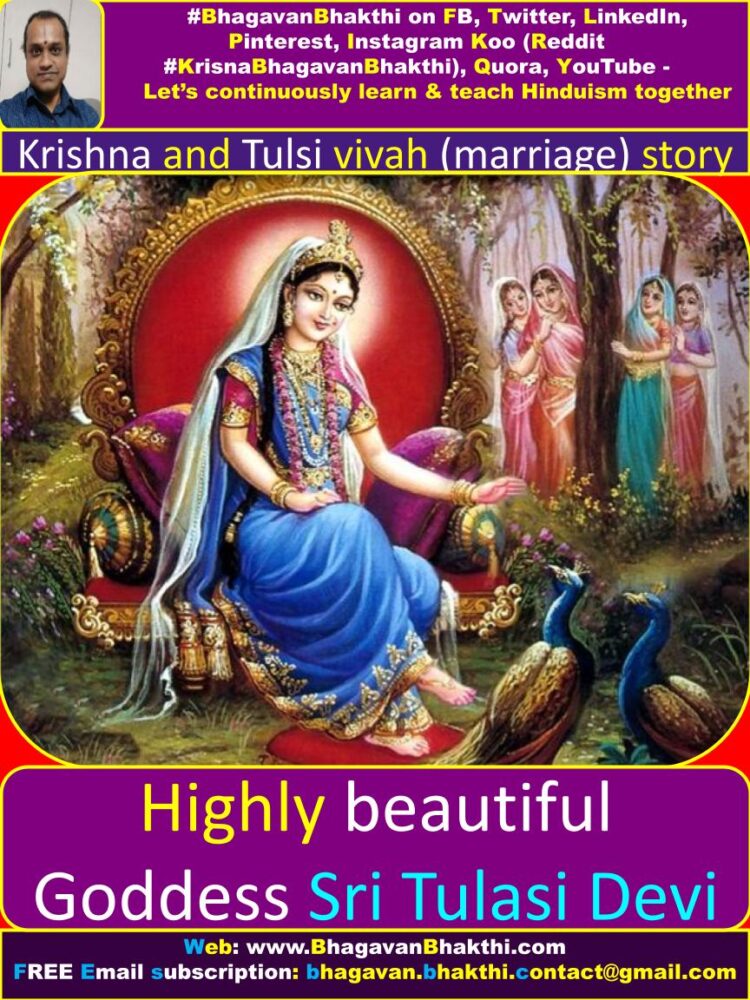
Ceremonial marriage of Sri Tulasi Devi plant with Lord Sri Vishnu is performed on this day.
It is customary to put Shaligram (Shaligram) (Saligram) (Lord Sri Vishnu form) and Sri Tulasi Devi’s plant to get marriage of them.
In Vaishnavas, use of japa malas (rosary) made from Tulasi plant’s stems or roots are in tradition.
Tulasi mani mala is referred to be auspicious for the wearer, and believed to put them under the protection of Lord Sri Vishnu (Hari).
These japa malas are used to count rama nama smarana, krishna nama smarana, raghavendra nama smarana, narayana nama smarana, etc.
Sannidhana (divine presence) of different Devatas (Demigods) in Tulasi plant. In Tulasi plant, there is sannidhana (divine presence) of various Tirthas like Pushkar (Pushkara), Ganga, etc.

Sannidhana (divine presence) of different Devatas (Demigods) in Tulasi plant:
In Tulasi plant, there is sannidhana (divine presence) of various Tirthas like Pushkara, Ganga, etc.
Lord Sri Brahma Deva, Lord Sri Rudra Deva (Shiva) and Lord Sri Vishnu all do have their sannidhana (divine presence) in the Tulasi plant.
Also there is Lord Sri Surya Deva, All Grahas (planets), Vishve Devataa, Ashta Vasus, Manus, Rishis, Vidyadharas, Gandharvas, Siddhas, Kinnaras, Kimpurushas, Apsaras, in each leaf of the Tulasi plant.
Lord Sri Vishnu (Hari) lives in the center of Tulasi leaf, where as Lord Sri Brahma Deva and Lord Sri Rudra Deva (Shiva) live in the two corners of the Tulasi leaf.
Similarly Goddess Sri Lakshmi Devi, Goddess Sri Sarasvati Devi, Goddess Sri Gayatri Devi, Goddess Sri Shachi Devi, etc.,
and also Lord Sri Indra Deva, Lord Sri Agni Deva, Lord Sri Yama Deva, Lord निर्ऋति (nirriti), Lord Sri Varuna Deva, Lord Sri Kubera, Lord Sri Vayu Deva etc. all live in the Tulasi plant.
It is said that Hanuman crossed the sea only after doing the vandana (worship) of Goddess Sri Tulasi Devi.
Nandeeshvara (Nandi) got the opportunity of worshipping Lord Shiva, only after he did the pooja of Goddess Sri Tulasi Devi.
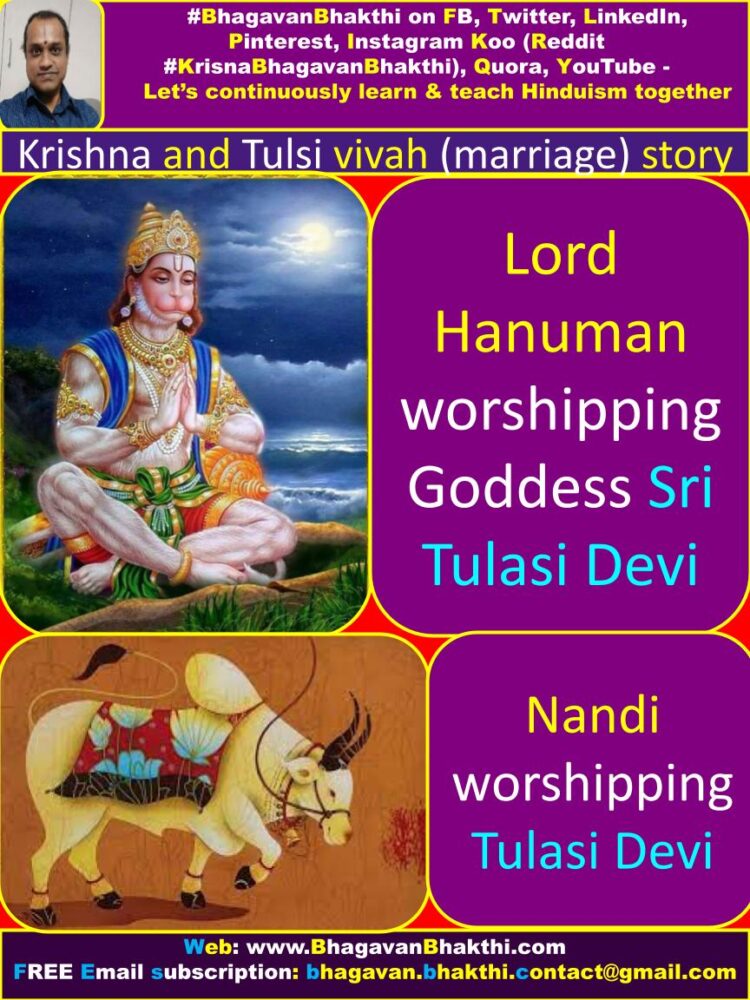
Padma Purana says that pooja without Tulasi is not pooja at all of all Devatas (Demigods) or Goddesses (Devis).
Snana (snan) (bath) without Tulasi Mruttika is not snana (snan) (bath). Any daana / donation given must have by Tulasi in it.
Garuda Purana says even though Tulasi plant is dry, it can be used for pooja / worshipping.
What is Uttana Dvadashi?
In Chaturmasya Ashada Shukla paksha Ekadashi, Lord Sri Vishnu (Hari) pretends to go on sleeping and in Bhadrapa Shukla paksha he will change the direction of his sleeping.
In Kartika Shukla Paksha Dvadashi Lord Sri Vishnu (Hari) will pretend to woke up, that day is called as Uttana Dvadashi.
On this Dvidalavrata and Chaturmasya Vrata (vrat) must be ended with the mantra.
Uttana Dvadashi also signifies the beginning of Kshira Sagara Manthana (Sagar Manthan) (Samudra Manthan) (churning of the milky Ocean).

Tulasi was born during Amrit Manthan. She is mostly liked by Lord Sri Vishnu (Hari). We usually pluck Tulasi leaves for the pooja of Lord Sri Vishnu (Hari).
इदं व्रतं मयादेव कृतं प्रीत्यै तव प्रभो । न्यूनं संपूर्णतां यातु त्वत्प्रसादात् जनार्धन॥
This dvadashi is also called as Prabhodini Dvadashi. – a day said to be the waking in of Lord Sri Vishnu (Hari) and the end of Chaturmasya (Four months).
How to pluck the Tulasi leaves details is as given below:
Bath should be taken, Achamanam to be done, Water to be poured at the roots of Tulasi Devi,
Then Prarthana (prayer) to be done to Tulasi Devi, Tulasi after plucking to be kept in a cleaned vessel,
Tulasi should not be washed. But other Flowers must be washed.
Ashta naama / Eight very important names of Goddess Sri Tulasi Devi is as given below:
Anyone who chant these 8 Great Names of Sri Tulasi Devi on daily basis, will get the same results as performing Ashvamedha yagna:
Vrinda (वृन्दा) : The goddess of all plant and trees (even if one Tulasi plant is present in a forest it can be called Vrindavana.)
Vrindavani (वृन्दावणी) : One who first manifested in Vrindavana.
Nandini (नंदिनी) : Seeing whom gives unlimited bliss to the bhaktas / devotees.
Pushpasaara (पुष्पसारा) : The topmost of all flowers, without whom Lord Sri Krishna does not like to look upon other flowers.
Tulasi (तुलसी) : One who has no comparison.
Vishvapoojita (विश्वपूजिता) : One whom the whole universe worships.
Krishna Jeevani (कृष्णा जीवनी) : The life of Sri Krishna.
Vishva Paavani (विश्व पावनि) : One who purifies the three worlds.
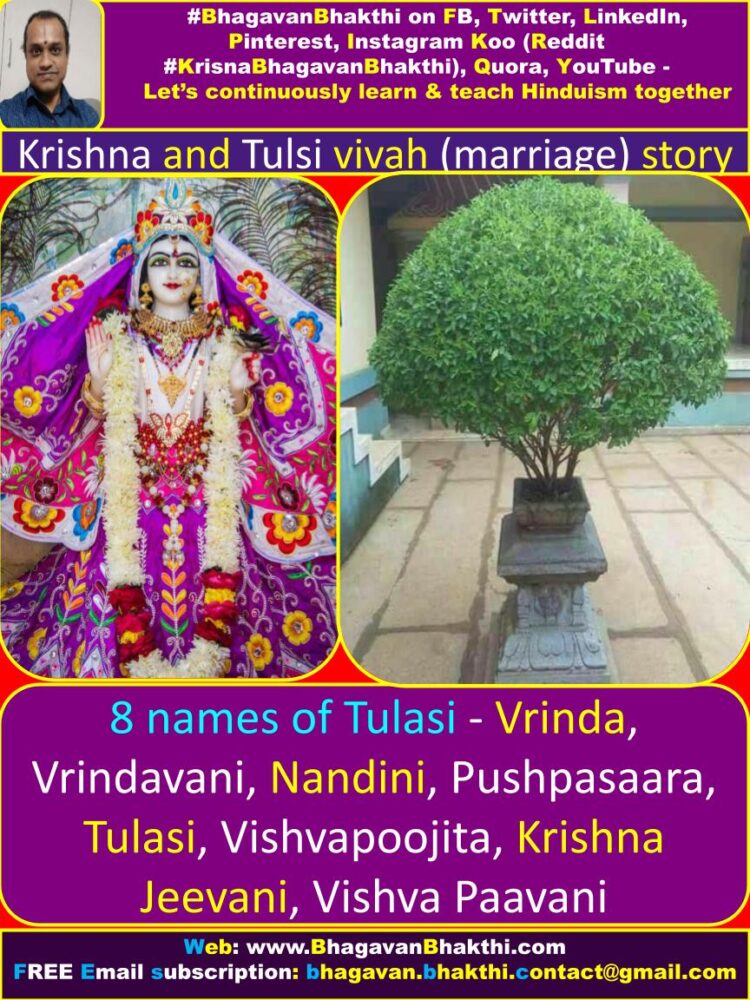
Greatness of Tulasi plant information is as given below:
Lord Sri Brahma Deva is said to be present in the branches of Tulasi plant, all Hindu Pilgrimages in its roots.
Similarly, Ganges is present in the Tulasi plant roots, all the Devatas (Demigods) in its stem and leaves, Vedas (Hindu scriptures) in the upper part of the plant.
It is believed that if a Tulasi stick is used to light Deepa (lamp) (diya) for Lord Sri Vishnu, it is equal to offering lakhs of Deepas (diyas) in prayers for many Devatas (Demigods) and Goddesses.
Worshiping Lord Sri Vishnu after smearing the paste made of dried wood of Tulasi is equal to several poojas and lakhs of Go-Daana (donation of cows).
When the Ganga water mixed with Tulasi leaf paste or leaves is given to the dying person, it is said that the departing soul will raise to the Svarga Loka (Heaven).

Insulting or contempt of Tulasi brings onto one the wrath and anger of Lord Sri Vishnu.
A prayer of forgiveness should be offered to Tulasi when it is plucked even for worship.
Tulasi plant should not be destroyed or de-rooted.
Waste things should not be thrown in the vicinity of the Tulasi plant.
The maintenance of the place in and around Tulasi plant should be clean and religious.
Getting moistened, sprinkled or anointed by Tulasi water will get the benefit of having taken a bath in all sacred rivers and performing all kinds of holy rituals and sacrifices.
According to Padma Purana, a person cremated with Tulasi twigs in his funeral pyre gains moksha (salvation) and a place in Vaikuntha / Vishnu’s abode.
(This depends on the person’s earlier Karma. But using Tulasi leaves will make the path easier).

Lord Sri Vishnu will be pleased to be gifted with a leaf of Tulasi rather than 1000 jars of honey.
Thus offering 1 leaf will beget the reward of offering million of cows and if it is offered in Kartika maasa / month, the rewards will be of many folds.
Worshiping Lord Sri Vishnu daily with a leaf of Tulasi will beget him the benefits of doing 100 thousand Ashvamedha (horse sacrifices) yagnas.
Similar benefits will be bestowed on the person who wears the necklace made of beads of Tulasi wood (Japa mala).
Anyone who leaves his body holding a Tulasi leaf in his hands will be saved from all the sins he has committed.
Anyone who lies or breaks promises or give false evidences in the presence of Tulasi plant or by holding Tulasi will go to hell.
Whoever worships Tulasi on the auspicious day of Uttana Dvadashi will be freed from all the sins and shall get a seat in Vaikuntha.
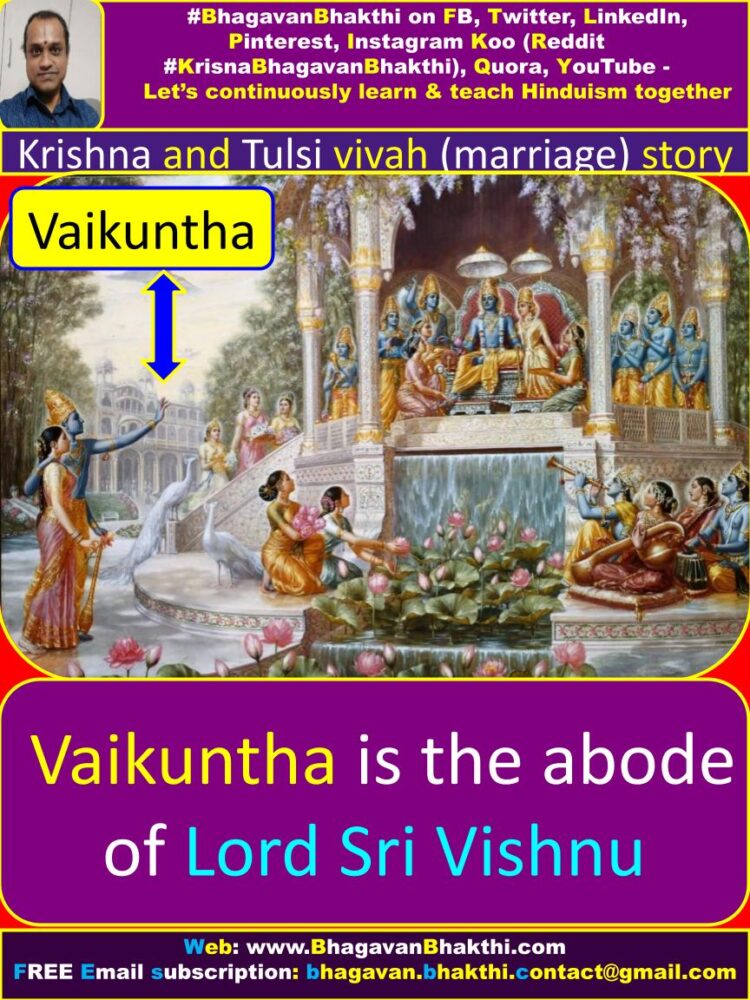
(This depends on the person’s earlier Karma. But using Tulasi leaves will make the path easier).
Tulasi and Jalandhara story is as given below:
Tulasi took birth during the samudra manthan / ocean churning between the Devatas (Demigods) and Asuras (Demons).
During the ocean churning, Lord Sri Dhanvantri (avatar of Lord Sri Vishnu), ‘the physician‘ emerged holding a pot containing Amrit, drinking which one becomes immortal.
During that time, Lord Sri Dhanvantri shed his tears of joy which fell in the pot containing Amrit, and from that emerged the ever holy, Goddess Sri Tulasi Devi (a plant).
As the plant was beautiful beyond comparison, Lord Sri Vishnu named it as Tulasi (meaning, which can not be compared with anyone).
Goddess Sri Tulasi Devi is considered to be a plant incarnation of Goddess Sri Lakshmi Devi.

The puranic legend of how Goddess Sri Lakshmi Devi assumed a form of a plant is found in ‘Brahma Vaivarta Purana‘.
According to this Brahma Vaivarta Purana, during Dvapara Yuga, Goddess Sri Tulasi Devi was a Gopika in her previous birth, also by same name Tulasi.
When she was with Lord Sri Krishna, another Gopika by name, Radha, cursed her to be separated from Lord Sri Krishna and be born as a human being.
As per the curse, Goddess Sri Tulasi Devi, was born as a daughter of King Dharmadhwaja and Shubhamati.
As their daughter was incomparable in beauty, they named her as Tulasi, which means, incomparable.
[This beauty was due to the presence of Goddess Sri Maha Lakshmi Devi within her, which means Sri Lakshmi Devi’s amsha (part) or Goddess Sri Lakshmi Devi’s sannidhi (divine presence).]
When Goddess Sri Tulasi Devi reached her youth, she went to Great place called Badri (Badrinath), to meditate (tapas / penance) upon Lord Sri Vishnu.
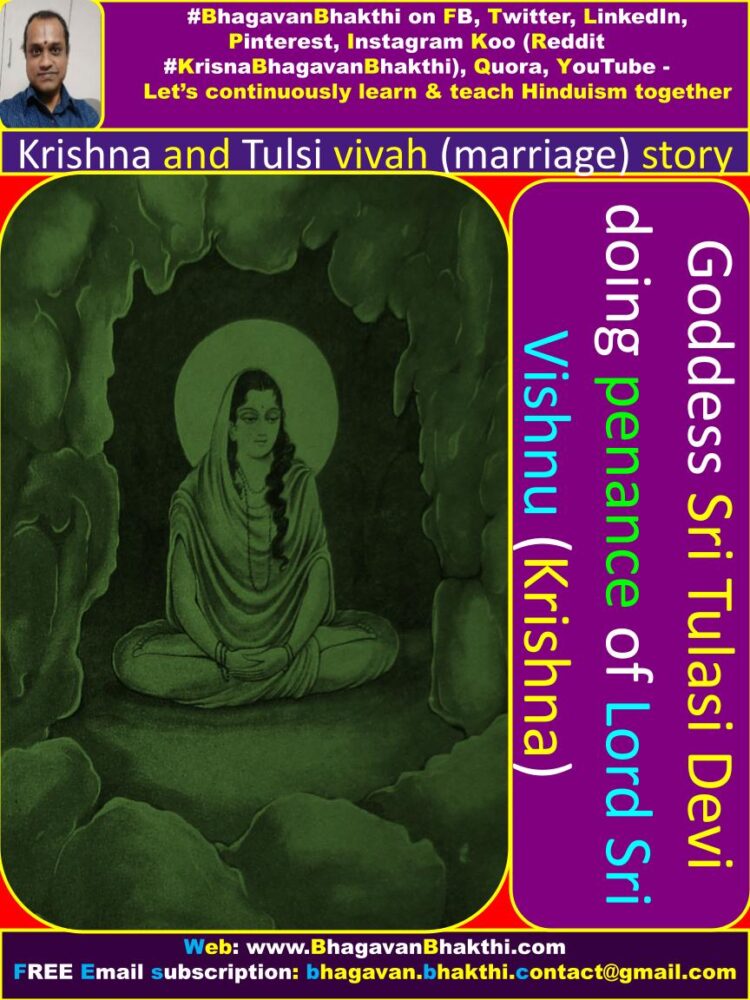
Lord Sri Brahma Deva appears before her and asks her the reason for her meditation.
Goddess Sri Tulasi Devi says that she remembers her previous birth and she is meditating to attain Lord Sri Vishnu.
Lord Sri Brahma Deva says her wish will be fulfilled and that she, in this birth, has to marry a demon by name, Shakhachooda (or Jalandhara).
Lord Sri Brahma Deva further says that, after her marriage to this demon, because of Lord Sri Vishnu’s maya (illusion), there would be circumstances which will have her to forsake her life and then later attain Lord Sri Vishnu.
Tulasi marries Shakhachooda (Jalandhara), but remains chaste and steadfast in her devotion towards Lord Sri Vishnu.
Shakhachooda (Jalandhara) prays to Lord Shiva for unparalleled strength and obtains it.
Shakhachooda (Jalandhara) then attacks Svarga Loka, defeats Lord Sri Indra Deva, and robs all the Devatas of their wealth.
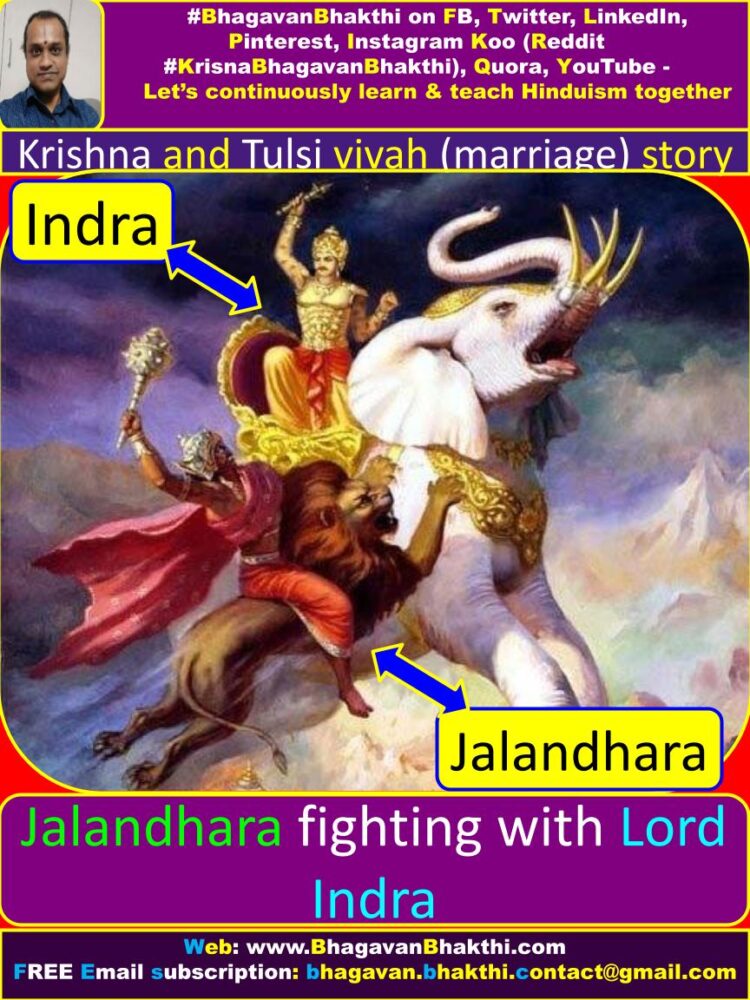
Shakhachooda (Jalandhara) takes away Kalpavriksha, Kamadhenu, chintamani (a wish fulfilling jewel) parijatha tree etc.
All the Devatas rushed to Lord Shiva to protect them. Lord Shiva agrees to fight the demon, but repeatedly looses battle against Shankhachooda (Jalandhara).
At this juncture, Devarishi (Sage) Narada, appears and informs Lord Shiva that Shakhachooda (Jalandhara) has remained undefeated and draws strength due to the virtue of his chaste wife, Goddess Sri Tulasi Devi.
As Goddess Sri Tulasi Devi had Goddess Sri Lakshmi Devi’s amsha (part), Lord Shiva approaches Lord Sri Vishnu for help.
Lord Sri Vishnu assumes the form of Shakhachooda (Jalandhara), casts spell on Tulasi and converses with her about “Trailokya Vijaya Kavacha Stotram”.
This stotram (prayer) is of Lord Sri Krishna, composed by Shankhachooda (Jalandhara) himself.
As Goddess Sri Tulasi Devi was distracted from her meditation of Lord Sri Vishnu, at that very moment Shankhachooda (Jalandhara) looses his strength and falls dead in battle field.

Lord Sri Vishnu then releases Goddess Sri Tulasi Devi from his spell.
On realizing the situation, an angered Goddess Sri Tulasi Devi curses Lord Sri Vishnu to turn into a stone.
Lord Sri Vishnu accepting her curse, he takes the form of a stone, which is nothing but the highly venerated Shaligrama (Shaligram) (Saligram) (Saligrama).
(Remember that no one can give shrapa / curse to Lord Sri Vishnu, but Lord Sri Vishnu will accept this curse to teach the lesson to the common man).
This Shaligrama (Shaligram) (Saligram) (Saligrama) can be found only in the river, Gandaki, in Nepal.

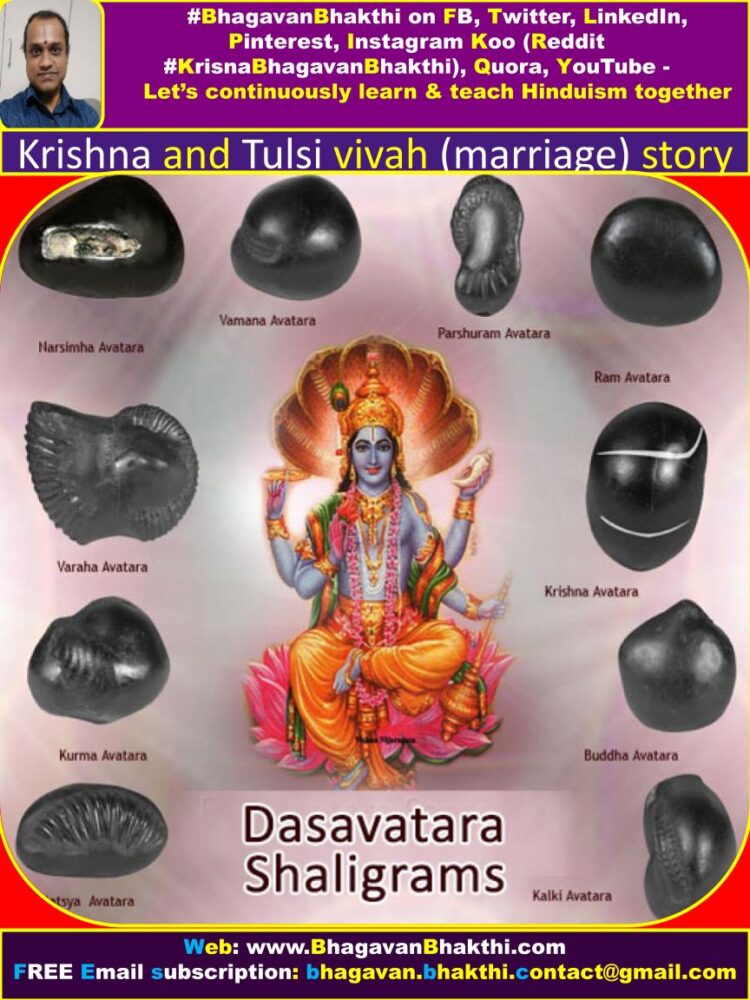
After cursing Lord Sri Vishnu to turn into a stone, Goddess Sri Tulasi Devi discards her body and becomes river Gandaki and her hair becomes the Tulasi plant.
Through this story we realize that Lord Sri Vishnu is antayyaamai / omnipresent.
To demonstrate Lord Sri Vishnu’s presence even in non-living beings, he assumes a form of a stone.
And as Lord Sri Vishnu and Goddess Sri Lakshmi Devi, the divine couple, are inseparable.
Goddess Sri Lakshmi Devi assumes a form of a river and a plant to be with her Lord Sri Vishnu.
A river, where alone Shaligrama (Shaligram) (Saligram) (Saligrama) can be found, and Tulasi plant, without which no worship of Lord Sri Vishnu is complete.
Thus authentic Hindu women pray to Goddess Sri Tulasi Devi to bestow on them “pativrata” (being loyal to husband all the time).
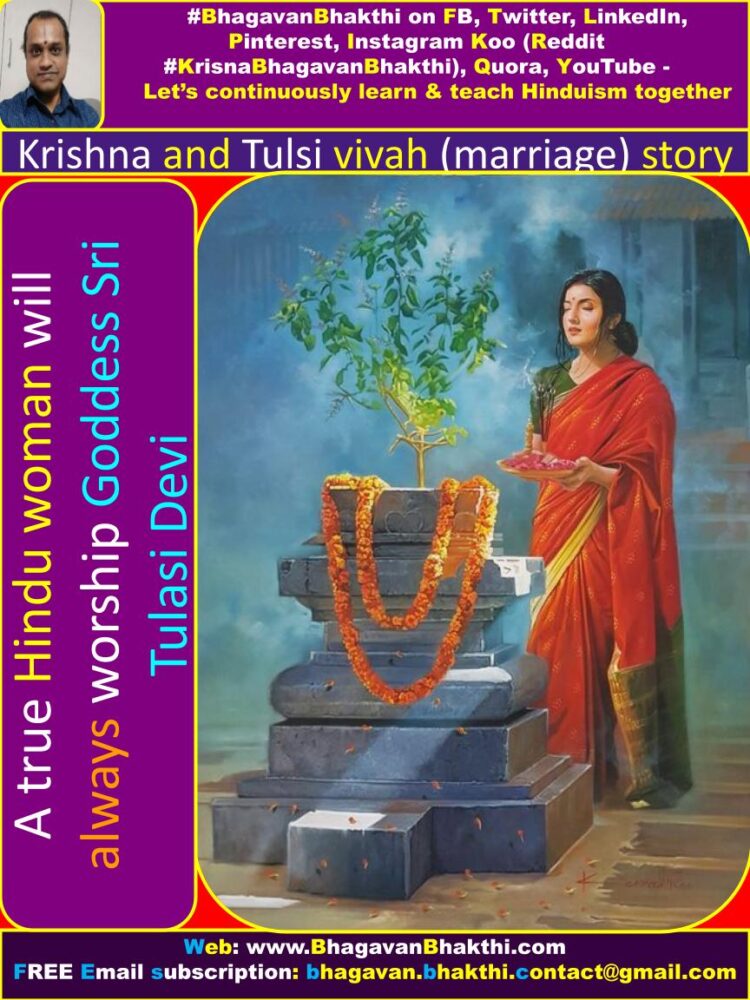
It is a customary for all married women to water tulasi plant and offer haldi, kukuma, after bath in the morning and light a oil lamp every evening.
As Lord Sri Vishnu and Goddess Sri Lakshmi Devi had married in Lord Sri Vishnu’s various avatars as Lord Sri Rama and Sri Sita Devi or as Lord Sri Krishna and Sri Rukmini Devi.
Similarly also during Kartika masam / month, on Uttana Dvadashi day, Lord Sri Vishnu, in the form of Shaligrama (Shaligram) (Saligram) (Saligrama) marries Goddess Sri Lakshmi Devi who is in the form of Tulasi plant.
This celestial wedding of Lord Krishna and Tulasi Vivaha (Vivah) is a fortnight after Deepavali (Diwali).
Goddess Sri Tulasi Vivaha (Vivah) is on Uttana Dvadasi day and this day falls in Kartika masam (month).
Kartika masam is known as “deepa maasam”, which means the season of lights.

Typically we see in various temples, the rows of light in evening and people gathering to sing devotional songs.
Deepavali (Diwali), the festival of lights, falls in Kartika masam (month) too.
Spiritually, light is associated with knowledge or enlightenment. And Lord Sri Damodara (another name of Lord Sri Krishna), is the patron deity of this masam (month) of Kartika.
The meaning of Damodara is someone who has “rope around his belly” (damo = rope, odara = belly).
Nobody can tie Lord Sri Krishna around his belly.
Only his mother, Yashoda, was able to do so. She was able to do so as she was filled with utmost love and devotion towards Lord Sri Krishna.
(Yashoada thought him to be her baby and did not want him to be wandering and getting hurt).

We too can tie our beloved Lord Sri Krishna with our unflinching devotion.
Hence during Sri Tulasi Vivaha (Vivah), we write on the tulasi-katta (brindavana), “Sri Kartika Radha Damodara Praseedatu”.
Information about the importance of Tulasi as per various Puranas is as given below:
Shiva Purana – As per Shiva purana on Dvadashi day, that is, on the sankramana period, both eclipses, Sundays, Fridays – Tulasi should not be gathered from the plant.
Tulasi should not be plucked from the plant by wearing cloth on the head, or with chappals on the feet, or with unclean body stage.
Linga Purana – As per Lingapurana, Puja should not be done without Tulasi.
Garuda Purana – As per Garuda Purana, Tulasi is the supreme amongst all the flowers, leaves etc.
Tulasi is mandatory. Tulasi to be brought by self preferably. However, if brought by others, only fifty percent phala (fruit) is obtained.

Brahma Purana – As per Brahma Purana, there is none equal to Tulasi (among all the plants, leaves etc.). Puja performed to Lord Sri Vishnu (Hari) without Tulasi has no use at all.
Even when Tulasi is unavailable, at least dry sticks of Tulasi should be offered after nirmalya visarjana.
If even the Tulasi stick is also unavailable, then at least the name “Tulasi” should be pronounced.
Vishnu Purana – Vishnu Purana states that the darshanam of Tulasi will bring and would give all phalas (fruits) equivalent to taking bath in all sacred and holy tirthas (rivers).
When the japa (chanting) is made of the mantras relating to Lord Sri Vishnu (Hari) with Tulasi Kashta Japa mala, then the phala (fruit) will be ten times more than the usual phala (fruit).
Narada Purana – Narada Purana states that one who collects and does puja to Lord Sri Vishnu (Hari) reciting the Great Vishnu Sahasra Naama would get the kingdom itself.
The number of Tulasi leaves that are submitted on the shira (head) of Lord Sri Vishnu (Hari) during puja, the devotee would live so much thousand of years as Lord Sri Vishnu bhakta / devotee.
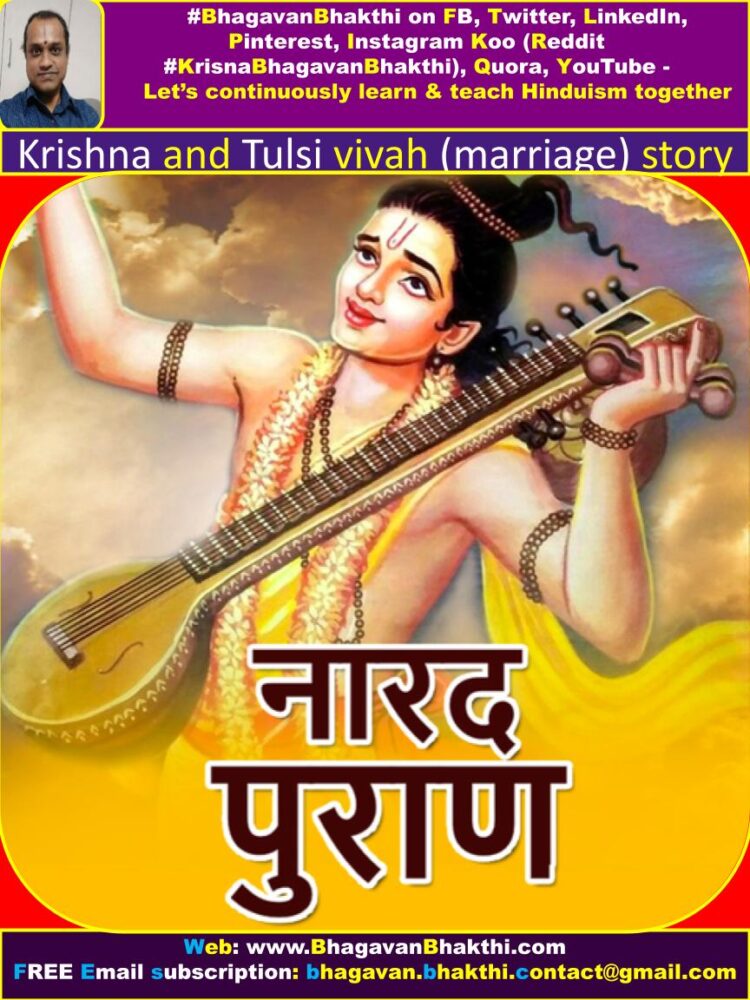
Agneya Purana – Agneya Purana states that one who does smarana (remember) of Tulasi, Lord Sri Vishnu and Ganga and do the puja, would definitely reach Vaikuntha.
Skanda Purana – Skanda Purana states that one who remembers Tulasi and does the puja would attain “Saarupya Moksha” and would not be born again all all.
Bhavishyat Purana – Bhavishyat Purana states that the recital of the names of Lord Sri Vishnu (Hari), Tulasi would provide jnanam (knowledge) and bhakti (devotion). All our sins would be destroyed.
Brahma Vaivarta purana – Brahma Vaivarta purana states that one who tender Tulasi to Lord Sri Krishna would be granted ‘Saayujya Moksha‘.
Markandeya Purana – Markandeya Purana states that the person who has Tulasi mala in his / her neck and who chants Lord Sri Vishnu (Hari) names with his tongue –
would never be in trouble from Kali (Kali of Kali Yuga) and he / she will never be disturbed by the Lord Sri Yama Deva and his dootas / servants.
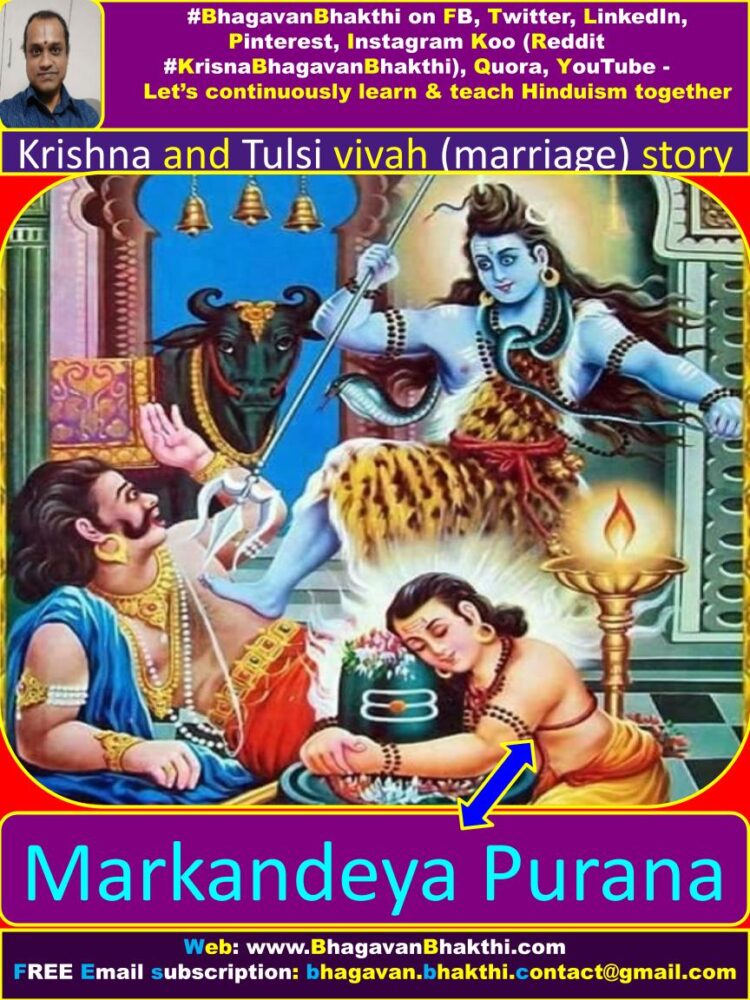
Vamana Purana – Vamana Purana states that in the roots of Tulasi all the sacred Tirthas reside. In the middle, all Devatas reside.
At the tip of the Tulasi, all the Great Vedas are there and for such Tulasi namaskaras are to be submitted.
Varaha Purana – Varaha Purana states that Lord Sri Varaha Svamy to be worshipped with devotion by Tulasi leaves.
There is no birth for a devotee who does dhyana (meditation) of Sri Varaha Svamy and Tulasi. Whoever does Puja without Tulasi being used in the puja, has to live in the hells for one manvantara.
Brahmanda Purana – Brahmanda Purana states that whoever does puja to Lord Sri Vishnu (Hari) with one hundred Tulasi leaves, his punya can’t be described.
He would be clearing off crores of sins like Brahma Hatya Dosha and other heinous crimes.
Vishnu Rahasya – Vishnu Rahasya states that, bath to be taken early in the morning before sunrise and Gayatri Mantra chanting to be done.
Then Lord Sri Vishnu (Hari) to be worshipped by pooja with Tulasi leaves. Such devotee would reach ‘Saayujya roopa moksha‘.
Now, let us know the stotram of Goddess Sri Tulasi (Tulsi) Devi.
Tulasi Stotram (Mantra) is as given below:
प्रसीद तुलसीदेवी प्रसीद हरिवल्लभे | क्षीरोदमथनोद्भोते तुलसीत्वां नमाम्यहं | यादृष्ठा निखिलाघसंगशमनी स्प्रुष्ट्पावपुपावनी |
रोगाणामभिवंदिता निरसनि सिक्तांतकत्रासिनि | प्रत्यासत्तिविधायिनी भगवत: कृष्णस्य संरोपिता | न्यस्ता तच्चरणे विमुक्तिफलदा तस्यै तुलस्यै नम: ।
prasīda tulasīdēvī prasīda harivallabhē | kṣīrōdamathanōdbhōtē tulasītvāṁ namāmyahaṁ | yādr̥ṣṭhā nikhilāghasaṁgaśamanī spruṣṭpāvapupāvanī |
rōgāṇāmabhivaṁditā nirasani siktāṁtakatrāsini | pratyāsattividhāyinī bhagavata: kr̥ṣṇasya saṁrōpitā | nyastā taccaraṇē vimuktiphaladā tasyai tulasyai nama: |
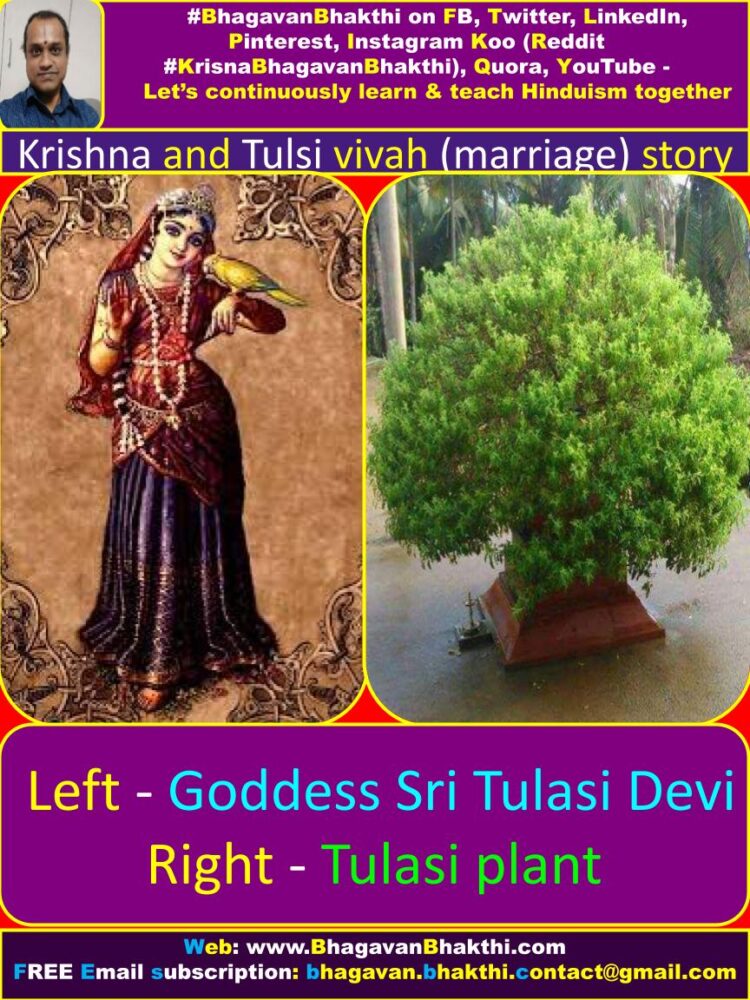
To watch videos on #Hinduism #Sanskrit language, SUBSCRIBE to my YouTube channel from this below link:
#BhagavanBhakthi YouTube channel
To know “Information about Tulasi (Tulsi) plant and Goddess Sri Tulasi (Tulsi) Devi“, please click the below link:
Information about Tulasi (Tulsi) plant and Goddess Sri Tulasi (Tulsi) Devi
Dear friends, if you need any clarifications about this post, kindly let me know, I will definitely try to answer all of them.
Also your one LIKE, one COMMENT, One Share, one SUBSCRIPTION is highly important.
This will help to know the quality of this content and also it will be helpful to know if any improvements is required for the content.
If you feel this content is useful to you and has helped you to improve your knowledge, kindly share this with your well-wishers.
Because “SHARING MEANS CARING”.
To receive FREE EMAIL SUBSCRIPTION about #BhagavanBhakthi, you can send an email to bhagavan.bhakthi.contact@gmail.com from your email ID.
NAMASTE!
Sri Gurubhyo Namaha
Sri Tulasi Krishnaaya Namaha
Sri Krishnaarpanamastu
Subscribe / Follow us Share in Social Media